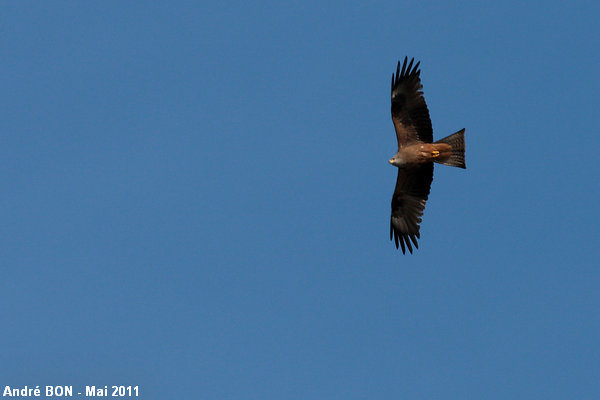
| Black Kite (Milvus migrans (Boddaert, 1783)) |

|
|
Scientific name: Milvus migrans (Boddaert, 1783) Common name: Black Kite French name: Milan noir Order: Accipitriformes Family: Accipitridae Size: Body size: 55 to 60 cm; Weight: 650 to 950 g; Wingspan: 135 to 155 cm. Habitat: Various habitats characterized by the presence of high trees or rocky cliffs and always near water, rivers or lakes. Food: The Black Kite is a carrion bird which feeds on dead animals. Fishes can represent more than 75% of its food. It is also used to following the plough to feed on disturbed animals. It may also feed on rubbish dumps. Nesting: The Black Kite nests in high trees or on rocky cornices, mainly near water. There are sometimes colonies of several tenths of nests. Females lay 2 or 3 eggs about late April. Migration: The European subspecies Milvus migrans migrans is migratory. It winters in Africa south of the Sahara. It arrives in Europe late March and flies back towards Africa in August. Geographic area: Temperate regions of Europe and Asia in summer. Sub-Saharan Africa, south-eastern Asia and Australasia as winter zone and for sedentary populations. |
The Black Kite is a rather dark brown bird. The upper side is a rather uniform colour. The under side, streaked with black, is grey on the chest and reddish at the rear. The whitish head is striated with brown. The bill is yellow near the base and black at the tip. The legs are yellow. I flight, the tail appears long, V-shaped and slightly forked. The feathers at the tip of the wing extend like long fingers. The under side of the primary remiges makes forms a paler patch compared to the other parts of the wing. The Red Kite (Milvus milvus) is a larger size. It is more rufous. Its tail is more deeply forked and rufous near the base. The under side of the primary remiges forms a well marked white patch. The Western Marsh-harrier (Circus aeruginosus) does not show so long finger-shaped feathers at the tip of the wings and has no white patch under the primary remiges. |
| [To know more about the Black Kite] [Top] |

|
I have observed two Black Kites during this weekend spent visiting the Basse Vallée du Doubs. The slow auto focus of the camera and the slowness of the photographer only permitted to shoot a couple of pictures in the far. This one is a crop. |